Of Mice and Men: Characters (Edexcel IGCSE English Literature): Revision Note
Exam code: 4ET1
Characters
Steinbeck’s characters symbolise ideas and represent elements of society. Therefore, it is important that you consider how Steinbeck portrays characters and how they reflect debates or themes. It is also very useful to explore how and why Steinbeck contrasts characters or shows similarities between them in Of Mice and Men.
Below you will find character profiles of:
Main characters
George Milton
Lennie Small
Curley
Curley’s wife
Other characters
Candy
Crooks
Slim
George Milton

George can be considered the protagonist of the story and is introduced in the beginning of the novella as he travels to a ranch for work
He represents an itinerant worker during the Great Depression
His friendship with Lennie and his plan to buy a piece of land sets him apart from the other itinerant workers:
He and Lennie are the only characters with surnames
The other characters are suspicious of their unusual friendship
George repeatedly tells Lennie that they are different to other itinerant workers because they have a “future”
George is presented sympathetically:
He is intelligent, observant and cautious
He is the sole care-giver to, and ally of, Lennie Small, his family friend
Readers are told he has looked after Lennie since Lennie’s Aunt Clara died
George’s character represents the idea of responsibility:
George’s good intentions are juxtaposed with the many challenges he faces
George’s sense of accountability and his determination to succeed weigh heavily
In this way, Steinbeck questions the American Dream
George’s characterisation throughout the novella illustrates the challenges of individuals who work hard to thrive while facing obstacles outside of their control:
He is described as “restless”, worried (he stares “morosely” into the fire), and impatient with Lennie
By the end, George realises his plans cannot be realised alongside Lennie
Despite earlier hopes, George realises he faces the future alone, like the others
In this way, Steinbeck uses his characterisation of George to represent the impossible circumstances facing itinerant workers
Lennie Small
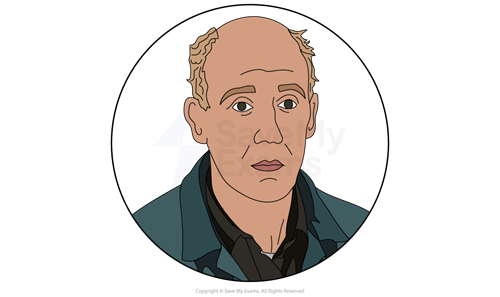
Lennie Small is the novella’s other protagonist:
However, his learning difficulties and child-like nature mean he is entirely reliant on George
His character represents the lack of social care in 1930s America:
Lennie was born with learning difficulties and was cared for by his Aunt Clara
This reinforces Steinbeck’s messages about the importance of communal care
As an itinerant worker, Lennie’s impairment places him in a vulnerable position:
Steinbeck presents him as George’s fierce “pet” when Curley starts a fight:
Lennie reacts only when George instructs him to retaliate
The boss suspects George is exploiting him
Lennie’s physical strength is his only advantage on the ranch, but Steinbeck presents this as the main cause of conflict in the novella
The novella’s poignant depiction of Lennie’s reliance on George is juxtaposed with the suspicion and conflict their friendship creates on the ranch:
Perhaps Steinbeck implies vulnerable individuals can become fearful and jealous
Steinbeck’s use of animal imagery suggests that Lennie is unpredictable, instinctive and physically strong:
His characterisation can be linked to the book’s title, which relates to a poem (by Robert Burns) that suggests small animals are subject to the invisible yet greater force of humans
Lennie’s surname is ironic: he is compared to a bear and a horse
When Lennie pets a small mouse too hard, and then kills a puppy the same way, Steinbeck shows Lennie’s power and foreshadows further tragedy
Despite his violence, Lennie is a sympathetic character, innocent and naive:
He likes caring for small animals and to touch soft things
He is upset when George admonishes him and is easily excited
Lennie’s tragic death at the end of the novella illustrates Steinbeck’s messages about the powerlessness of disadvantaged individuals in harsh conditions
Curley
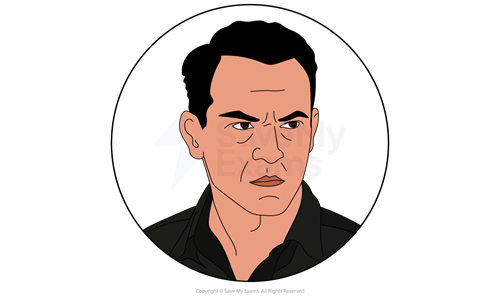
Curley is the boss’s son and thus represents a powerful individual with status and land:
Steinbeck may have used his character to depict the result of wealth inequalities during the Great Depression and to represent the land-owning class
He can be seen as a foil character for Slim, the “jerkline skinner”:
While Slim appears to bring a sense of calm to the ranch (which gains him respect and trust), the workers call Curley a coward behind his back
Equally, Curley’s quick-temper makes the men fear him
Steinbeck presents Curley as the novella’s antagonist:
Steinbeck’s characterisation of Curley exemplifies a powerful individual whose insecurity brings conflict and tragedy
Curley is introduced as aggressive in his stance and actions:
He is “pugnacious” (quick to anger), which Steinbeck illustrates when Curley singles out Lennie for his physical strength and size
His hands close “into fists” and he moves into a “slight crouch”
When Candy explains that Curley is like a “lot of little guys” who hate “big guys”, Steinbeck foreshadows the conflict Curley’s insecurity will bring to the ranch
Curley attempts to control others with fear and intimidation:
He is characterised by his small size and his desperate desire to exert authority
He appears to flaunt his position wearing “high-heeled boots”
This, and his paranoia over his wife, isolates him from the rest of the ranchers
When Curley tells the men he wears one glove to keep his hand smooth for his wife, Steinbeck shows how, instead of earning him respect, this serves as a threat
Curley’s characterisation can be seen as an illustration of sexism: he attempts to limit his wife’s freedoms and restrict her dreams
Curley’s wife
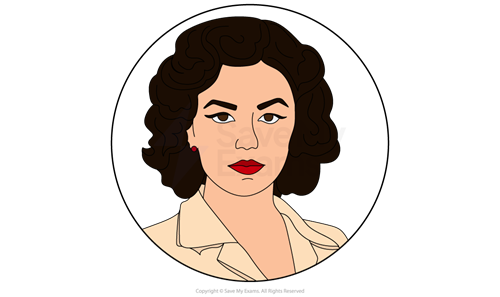
Curley’s wife, the only female on the ranch, represents a marginalised and displaced woman whose marriage isolates her and, ultimately, leads to her death
She can be considered one of the least powerful individuals on the ranch:
She is not given a name
She is ignored by almost all the men on the ranch (except Lennie) as she is seen as a sexual threat
Her husband perceives her as a possession and a sexual object
While the men have the option to work towards their dream, Steinbeck portrays Curley’s wife’s dream as a fantasy:
Steinbeck emphasises how she dreamed she could “make something” of herself as a Hollywood filmstar
Yet, unlike the other men, Steinbeck presents her situation as hopeless as she is unable to earn money
Her limited agency is highlighted when she tells Lennie she married Curley as a way to progress her opportunities, but that Curley “ain’t a nice fella”
Steinbeck portrays gender attitudes in 1930s America through the men’s reactions:
Candy calls her a “tart” and a “tramp”
Her sexuality is perceived as a threat to the mens’ jobs
She is seen as a temptress and a femme fatale, much like the sex-workers in the town where the men spend their money:
This is highlighted, perhaps, with the motif of red clothing
Lennie has previously lost a job for touching a girl’s red dress
Curley’s wife is described as having red fingernails, lips and shoes
Steinbeck portrays Curley’s wife as an annoyance to the men:
She is introduced as “heavily made-up”, with a “nasal” voice
She is perceived as a bad wife, flirtatious and vain
Her isolation leads her to look for company with the other men, particularly the weaker characters such as Crooks and Lennie:
Her bitter threat to Crooks presents her as dangerous because of her marriage
Steinbeck uses natural imagery to depict how Curley’s wife disrupts order on the ranch:
When she meets Lennie, the “rectangle of sunshine in the doorway was cut off”
Steinbeck mirrors this when she is killed: “the sun went down, and the sun streaks climbed up the wall and fell”
Minor characters
Candy
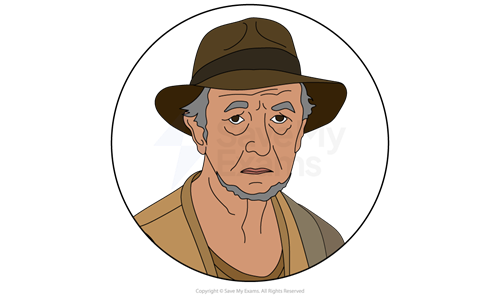
Candy, an old rancher who has lost a hand in an injury, is a “swamper” or cleaner
His character represents attitudes towards the elderly in 1930s America
Steinbeck’s characterisation of Candy is sympathetic:
His place on the ranch is unstable and is mirrored in the depiction of his old dog
The dog is “so God damn old he can't hardly walk” and “damn near blind”
Steinbeck’s portrayal of Candy’s dog conveys the hopelessness Candy feels
Candy’s brief hope that he and George can buy their own piece of land reflects Steinbeck’s ideas about the futility of making plans in 1930s America
Crooks
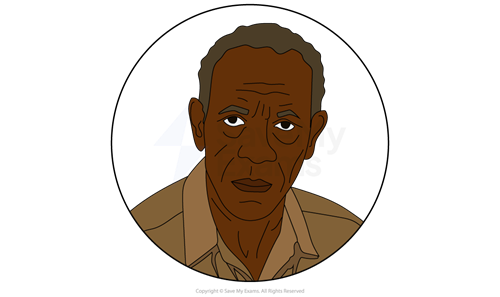
Crooks is the “stable-buck”, another character who is marginalised and disenfranchised
Crooks’s name comes from his crooked back, the result of a horse kick
However, Crooks is included in the novella particularly to explore racism:
He is segregated from the other ranchers and lives in the stable with the animals
Some of the men on the ranch use racial slurs when they discuss him, especially Candy, the oldest rancher
Steinbeck highlights prejudice by portraying Crooks as intelligent and disciplined:
He is proud of his heritage and nostalgic about his childhood on his father’s chicken ranch where the “white kids” came to play
His knowledge of legal rights, and how few he has, makes him angry and “aloof”
Steinbeck exemplifies how Crooks’s race disempowers him:
He is “reduced” to “nothing” by another minority character, Curley’s wife
Slim
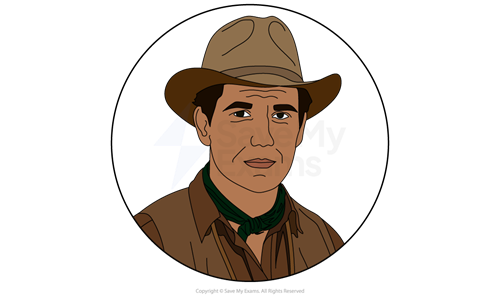
Slim is the jerkline skinner on the ranch and functions, mainly, as support to George, who treats Slim as a confidante
He is calm and liked by the men
He gives Lennie one of the new puppies and attempts to help Candy

Unlock more, it's free!
Did this page help you?